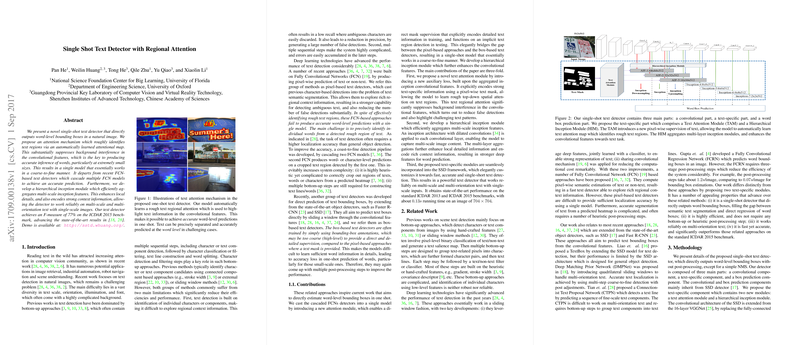An Evaluation of the Single Shot Text Detector with Regional Attention
The paper "Single Shot Text Detector with Regional Attention" introduces a novel approach to text detection that efficiently predicts word-level bounding boxes in natural images. The research presents a significant advancement in scene text detection by implementing a single-shot model that utilizes a newly designed attention mechanism alongside a hierarchical inception module. These innovations aim to address the limitations of previous text detection systems that rely heavily on multiple sequential processes, which often result in accumulated errors and reduced precision.
The authors propose a single-shot text detection framework that challenges the traditional heavy-bottom-up method by relying on a direct approach enhanced by regional attention. The key feature of this model is the text attention module, which allows the convolutional network to automatically focus on text regions, thereby minimizing background interference that typically plagues text detection accuracy. The combination of this attention mechanism with a hierarchical inception module leverages the convolutional features more efficiently, resulting in enhanced local details and robust context information. This combination enables the model to reliably detect multi-scale and multi-orientation text using a single image scale.
The authors claim advancement over state-of-the-art performance, providing comparative results on the ICDAR 2013 and ICDAR 2015 datasets. The paper demonstrates significant improvements in recall and precision, with a reported F-measure of 0.87 on the ICDAR 2013 benchmark under the new ICDAR13 standard. This indicates enhanced word-level detection capabilities. Furthermore, in the context of multi-orientation text detection on the ICDAR 2015 dataset, the model achieves an F-measure of 0.77, outperforming existing models such as CTPN and DMPNet, which had previously defined performance benchmarks in the field.
It is pertinent to highlight the paper's methodological approach, which significantly reduces the complexity typically associated with text detection systems. By integrating the proposed attention module within the SSD framework, the model ensures a balance between computational efficiency and detection accuracy. The hierarchical inception module, inspired by GoogleNet's inception architecture, addresses challenges related to multi-scale text detection by improving the multi-scale capability of the model.
The implications of this research are both practical and theoretical. Practically, it promises robust and efficient text detection applicable to various real-world scenarios such as image retrieval, robotic navigation, and scene understanding, where robust text detection significantly enhances performance. Theoretically, this paper contributes to the evolving understanding of attention mechanisms within convolutional neural networks, demonstrating how they can be employed to focus on relevant features and improve detection outcomes in cluttered and dynamic environments.
Future developments in AI can build on these findings to further refine text detection systems, possibly extending them to more diverse environments and exploring the integration of these techniques with other vision-based tasks. Ongoing research might explore adaptive attention mechanisms that allow even more precise localization and identification of complex, overlapping texts across a broader spectrum of scales and orientations.
In conclusion, this paper provides a compelling argument for the utilization of regional attention mechanisms in text detection systems. The combination of structural efficiency and empirical performance underscores its potential as a valuable tool in the modern computer vision landscape.
